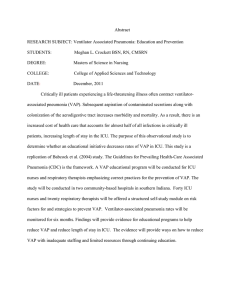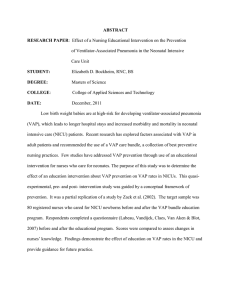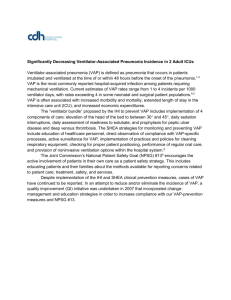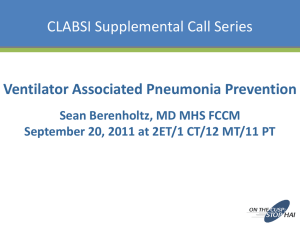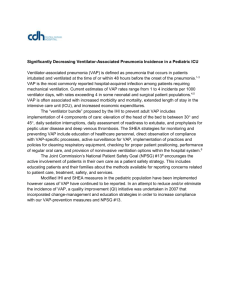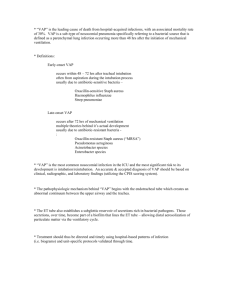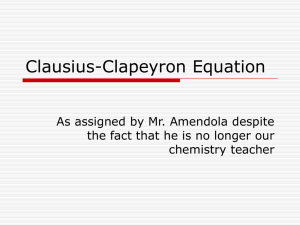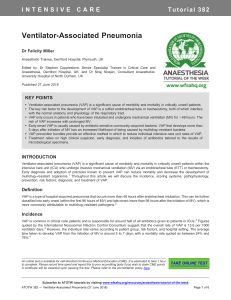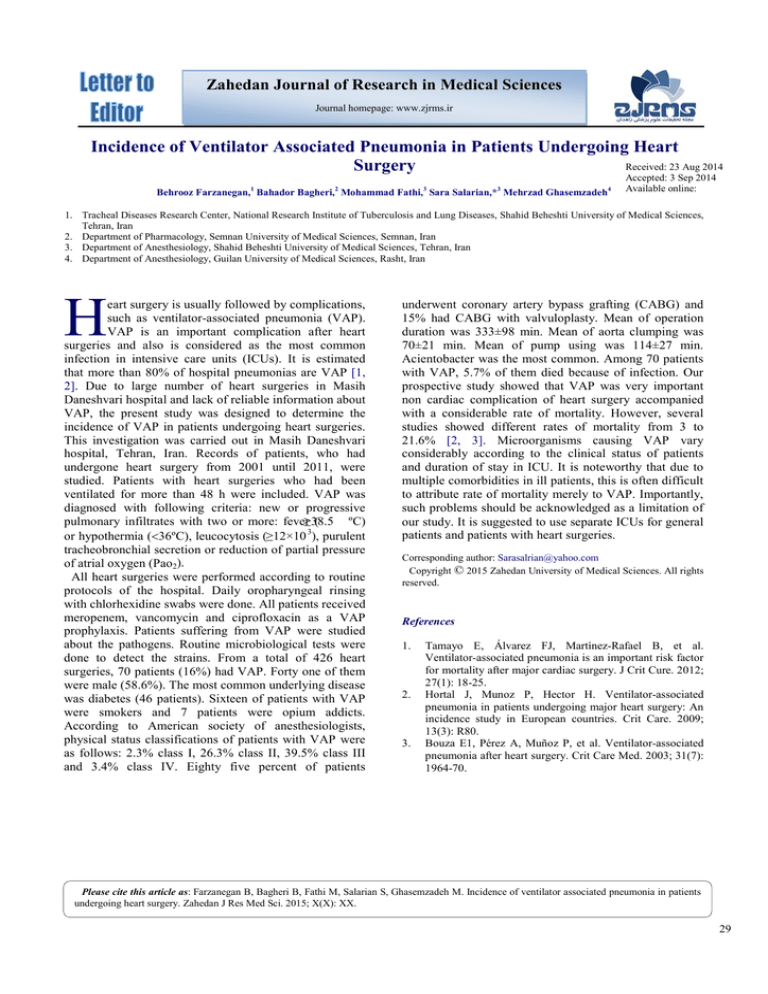
Zahedan Journal of Research in Medical Sciences
Journal homepage: www.zjrms.ir
Incidence of Ventilator Associated Pneumonia in Patients Undergoing Heart
Received: 23 Aug 2014
Surgery
Behrooz Farzanegan,1 Bahador Bagheri,2 Mohammad Fathi,3 Sara Salarian,*3 Mehrzad Ghasemzadeh4
Accepted: 3 Sep 2014
Available online:
1. Tracheal Diseases Research Center, National Research Institute of Tuberculosis and Lung Diseases, Shahid Beheshti University of Medical Sciences,
Tehran, Iran
2. Department of Pharmacology, Semnan University of Medical Sciences, Semnan, Iran
3. Department of Anesthesiology, Shahid Beheshti University of Medical Sciences, Tehran, Iran
4. Department of Anesthesiology, Guilan University of Medical Sciences, Rasht, Iran
H
eart surgery is usually followed by complications,
such as ventilator-associated pneumonia (VAP).
VAP is an important complication after heart
surgeries and also is considered as the most common
infection in intensive care units (ICUs). It is estimated
that more than 80% of hospital pneumonias are VAP [1,
2]. Due to large number of heart surgeries in Masih
Daneshvari hospital and lack of reliable information about
VAP, the present study was designed to determine the
incidence of VAP in patients undergoing heart surgeries.
This investigation was carried out in Masih Daneshvari
hospital, Tehran, Iran. Records of patients, who had
undergone heart surgery from 2001 until 2011, were
studied. Patients with heart surgeries who had been
ventilated for more than 48 h were included. VAP was
diagnosed with following criteria: new or progressive
pulmonary infiltrates with two or more: fever≥38.5
(
ºC)
or hypothermia (<36ºC), leucocytosis (≥12×10 3), purulent
tracheobronchial secretion or reduction of partial pressure
of atrial oxygen (Pao2).
All heart surgeries were performed according to routine
protocols of the hospital. Daily oropharyngeal rinsing
with chlorhexidine swabs were done. All patients received
meropenem, vancomycin and ciprofloxacin as a VAP
prophylaxis. Patients suffering from VAP were studied
about the pathogens. Routine microbiological tests were
done to detect the strains. From a total of 426 heart
surgeries, 70 patients (16%) had VAP. Forty one of them
were male (58.6%). The most common underlying disease
was diabetes (46 patients). Sixteen of patients with VAP
were smokers and 7 patients were opium addicts.
According to American society of anesthesiologists,
physical status classifications of patients with VAP were
as follows: 2.3% class I, 26.3% class II, 39.5% class III
and 3.4% class IV. Eighty five percent of patients
underwent coronary artery bypass grafting (CABG) and
15% had CABG with valvuloplasty. Mean of operation
duration was 333±98 min. Mean of aorta clumping was
70±21 min. Mean of pump using was 114±27 min.
Acientobacter was the most common. Among 70 patients
with VAP, 5.7% of them died because of infection. Our
prospective study showed that VAP was very important
non cardiac complication of heart surgery accompanied
with a considerable rate of mortality. However, several
studies showed different rates of mortality from 3 to
21.6% [2, 3]. Microorganisms causing VAP vary
considerably according to the clinical status of patients
and duration of stay in ICU. It is noteworthy that due to
multiple comorbidities in ill patients, this is often difficult
to attribute rate of mortality merely to VAP. Importantly,
such problems should be acknowledged as a limitation of
our study. It is suggested to use separate ICUs for general
patients and patients with heart surgeries.
Corresponding author: Sarasalrian@yahoo.com
Copyright © 2015 Zahedan University of Medical Sciences. All rights
reserved.
References
1.
2.
3.
Tamayo E, Álvarez FJ, Martínez-Rafael B, et al.
Ventilator-associated pneumonia is an important risk factor
for mortality after major cardiac surgery. J Crit Cure. 2012;
27(1): 18-25.
Hortal J, Munoz P, Hector H. Ventilator-associated
pneumonia in patients undergoing major heart surgery: An
incidence study in European countries. Crit Care. 2009;
13(3): R80.
Bouza E1, Pérez A, Muñoz P, et al. Ventilator-associated
pneumonia after heart surgery. Crit Care Med. 2003; 31(7):
1964-70.
Please cite this article as: Farzanegan B, Bagheri B, Fathi M, Salarian S, Ghasemzadeh M. Incidence of ventilator associated pneumonia in patients
undergoing heart surgery. Zahedan J Res Med Sci. 2015; X(X): XX.
29

